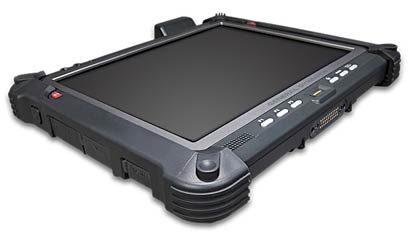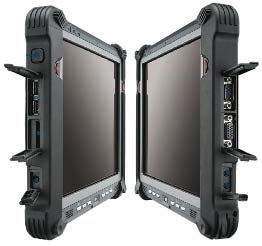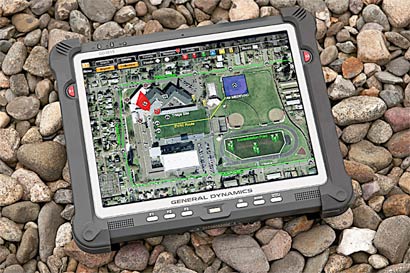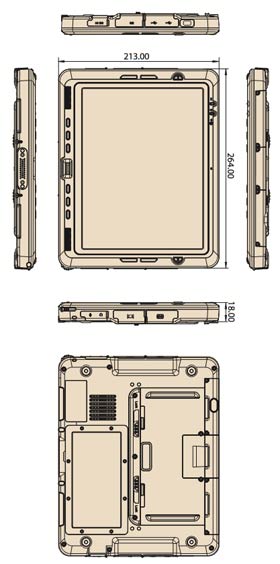|
General Dynamics Itronix GD3015
Semi-rugged fanless Intel Atom-powered tablet for a wide range of commercial or industrial applications
(by Conrad H. Blickenstorfer, June 2011)
On June 30, 2011, General Dynamics Itronix released the GD3015, a semi-rugged tablet computer and complement to the company's fully rugged tablets. The goal for the new machine is to provide a wide range of communications and data capture capabilities to mobile professionals working in public safety, utilities, transportation, warehousing and industry field services. And to do so in a lightweight, fanless design that weighs less than three pounds, yet is capable of running Windows 7 Professional.

In terms of design and functionality, the GD3015 splits the difference between the new generation of iPad-style media tablets and the heavier and much more rugged workhorse tablets that have been performing important tasks out there in the field for many years.
With a modest footprint of 10.4 x 8.4, a slender profile of just 0.7 inches (presumably measured without the protective bumper strips), and weighing well under three pounds, the GD3015 is more ruggedized media tablet than rugged Tablet PC. Also iPad-like is the 10.4-inch 1024 x 768 pixel display.
 That, however, is where the similarity ends. The GD3015 is a Windows machine, running full Windows 7 Professional. With a 3-foot drop spec and IP54 sealing it's much more rugged than consumer media tablets. It has standard PC-style ports—2 USB, video, audio, RS232 serial, albeit no LAN. And those ports are all nicely protected by a sturdy rubber bumper/grip on each side that also keeps the device from getting scratched. And the touchscreen is a 4-wire resistive affair, and not projected-capacitive multi-touch. So no fancy pinching and scrolling here, but it all works with gloves on and when it's wet. That, however, is where the similarity ends. The GD3015 is a Windows machine, running full Windows 7 Professional. With a 3-foot drop spec and IP54 sealing it's much more rugged than consumer media tablets. It has standard PC-style ports—2 USB, video, audio, RS232 serial, albeit no LAN. And those ports are all nicely protected by a sturdy rubber bumper/grip on each side that also keeps the device from getting scratched. And the touchscreen is a 4-wire resistive affair, and not projected-capacitive multi-touch. So no fancy pinching and scrolling here, but it all works with gloves on and when it's wet.
In terms of technology, the GD3015 has an Intel Atom processor under the hood. I won't go into an explanation of the whole expanding Atoms family here. Suffice it to say that the GD3015 comes with a 1.6GHz Z530, a member of the original first-gen "Silverthorne" family of Atom chips designed for Internet access devices, and enjoying embedded status, which means Intel will keep making it for years to come. The Z530 has also become pretty much the processor of choice for economical industrial tablets and panels. It uses very little power, generates very little heat, yet is perfectly capable of running even full operating systems like Windows 7.

Maximum RAM is 2GB, and standard mass storage is a 160GB 1.8-inch hard disk. Optionally available is a 64GB slid state disk, and those who may want to configure their GD3015 with a (presumably available) embedded OS may consider an 8GB CompactFlash version. The standard battery is a bit on the weak side with just 21 watt-hours and so we recommend the optional external battery with twice the punch (it probably snaps on somehow). For expansion, there's a PC Card slot with Cardbus 2.1 support, and an SD card slot.
Wireless connectivity includes Bluetooth 2.0 (2.1 would be nicer for the additional security), 802.11 b/g/n WiFi, and optional 3G WWAN. Customers can also specify GPS, a 2-megapixel camera, and a variety of data capture options: a laser scanner, 13.56MHz RFID, GPS, or even a magnetic card reader.
The 10.4-inch display uses the 4:3 aspect ratio. It is a transflective design said to be sunlight viewable, so presumably it does not use the formidable Itronix DynaVue technology.
Where does the GD3015 fit in? According to Mark Johnston, director of Strategic Computing Solutions at General Dynamics Itronix, "he GD3015 pairs ruggedness with a Windows-based operating system so budget-constrained IT managers have a computing solution that is easy to deploy, minimizes training costs for users and leverages existing software and operating system configurations." "Budget-constrained" here means a starting price of US$2,400. That's modest compared to fully rugged tablets, but still quite a bit compared to the new breed of media tablets. But then, this is not a gadget you buy at a discount store. It is an industrial-strength tool for the job.
|
|
|
|
Specifications
|
|
Added/changed
|
Added 06/2011
|
|
Processor
|
Intel Atom Z530XL
|
CPU Speed
|
1.6 GHz
|
TDP
|
2.2 watts
|
OS
|
Windows 7 Professional
|
Chipset/Graphics
|
US15W XL
|
Standard/Max RAM
|
Up to 2GB DDR2
|
Disk/drive
|
1.8" 160GB hard disk; optional 64GB SSD or 8GB CompactFlash
|
Card slots
|
1 PC Card Type II (supports Cardbus 2.1), 1 SD Card, 1 SIM (optional), SmartCard (optional)
|
Display type
|
Sunlight-viewable transflective TFT LCD with 300 nits backlight
|
Display size/res
|
10.4" XGA (1024 x 768 pixel)
|
Digitizer/pens
|
4-wire resistive touch screen
|
Keyboard/scale
|
Onscreen, optional external USB
|
Housing
|
Unknown
|
Operating Temp
|
32 to 104F (0 to 40C)
|
Sealing
|
IP54
|
Shock
|
Multiple 3-foot drops to plywood
|
Humidity
|
5% to 95% non-condensing
|
Size (WxHxD)
|
10.4 x 8.4 x 0.7 inches
|
Weight
|
2.7 lbs.
|
Security
|
Pre-boot and supervisor password, TPM v1.2, Fingerprint Reader, Computrace BIOS software, Intel Trusted Execution Technology (TXT), Virtualization Technology (VT); Smart Card (optional)
|
Power
|
Rechargeable 11.1V/1,900mAH Li-Ion smart battery; optional external 11.1V/3,800mAH battery
|
Communications
|
802.11 b/g/n WiFi, Bluetooth class 2, V2.0+EDR: optional: 3G GPRS/HSDPA, 2mp camera, GPS, 1D laser scanner, mag stripe reader (1+2+3), 13.56MHz RFID
|
Interface
|
2 USB 2.0 host, VGA, audio in/out, RS232, docking, power |
List price
|
Starting at US$2,400
|
Contact
|
www.gd-itronix.com, 1-509-626-4203
|
Brochure
|
GD3015 PDF brochure
|
|

|
|
Definitions and Primers
|
|
Active vs passive digitizers
What does "rugged" mean?
Rugged Specs Primer
FIPS 201
Intrinsic Safety
NEMA Ratings
NVIS standards
IEC 60601
IP Rating
RFID
RFID vs. Bar Code
RFID viruses and worms
RoHS
Outdoor-readable screens
MIL-STD-461E
Wide-angle LCDs
|
|



